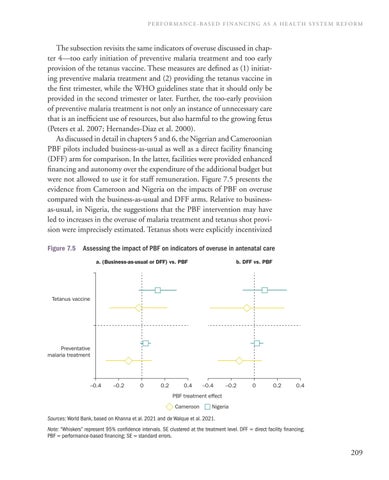P erformance - B ased F inancing as a H ealth S ystem R eform
The subsection revisits the same indicators of overuse discussed in chapter 4—too early initiation of preventive malaria treatment and too early provision of the tetanus vaccine. These measures are defined as (1) initiating preventive malaria treatment and (2) providing the tetanus vaccine in the first trimester, while the WHO guidelines state that it should only be provided in the second trimester or later. Further, the too-early provision of preventive malaria treatment is not only an instance of unnecessary care that is an inefficient use of resources, but also harmful to the growing fetus (Peters et al. 2007; Hernandes-Diaz et al. 2000). As discussed in detail in chapters 5 and 6, the Nigerian and Cameroonian PBF pilots included business-as-usual as well as a direct facility financing (DFF) arm for comparison. In the latter, facilities were provided enhanced financing and autonomy over the expenditure of the additional budget but were not allowed to use it for staff remuneration. Figure 7.5 presents the evidence from Cameroon and Nigeria on the impacts of PBF on overuse compared with the business-as-usual and DFF arms. Relative to businessas-usual, in Nigeria, the suggestions that the PBF intervention may have led to increases in the overuse of malaria treatment and tetanus shot provision were imprecisely estimated. Tetanus shots were explicitly incentivized Figure 7.5
Assessing the impact of PBF on indicators of overuse in antenatal care a. (Business-as-usual or DFF) vs. PBF
b. DFF vs. PBF
Tetanus vaccine
Preventative malaria treatment
–0.4
–0.2
0
0.2
0.4
–0.4
–0.2
0
0.2
0.4
PBF treatment effect Cameroon
Nigeria
Sources: World Bank, based on Khanna et al. 2021 and de Walque et al. 2021. Note: “Whiskers” represent 95% confidence intervals. SE clustered at the treatment level. DFF = direct facility financing; PBF = performance-based financing; SE = standard errors.
209

